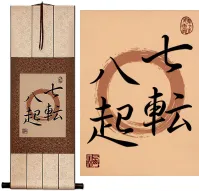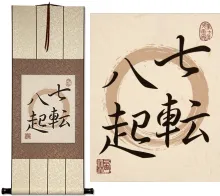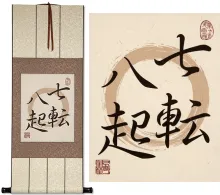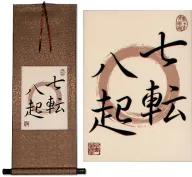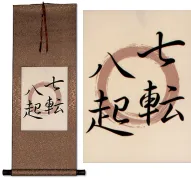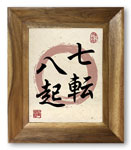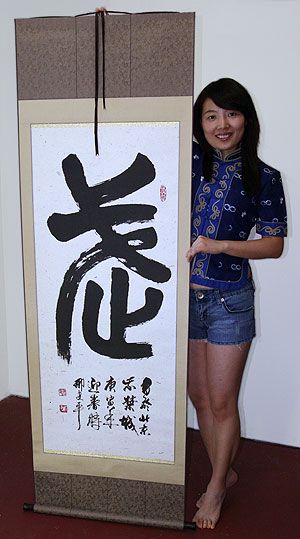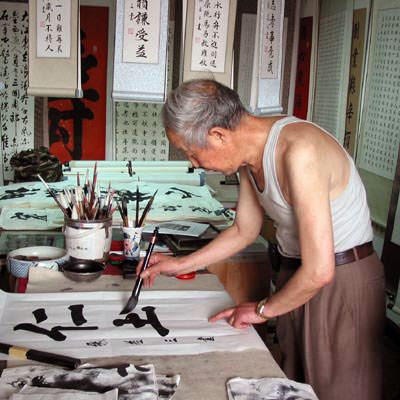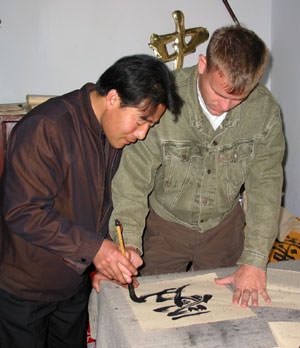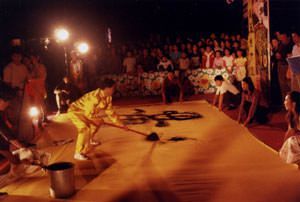Many custom options...
And formats...

The name Fall 7 Rise 8 in Chinese / Japanese...
Buy a Fall 7 Rise 8 calligraphy wall scroll here!
Personalize your custom “Fall 7 Rise 8” project by clicking the button next to your favorite “Fall 7 Rise 8” title below...
This in-stock artwork might be what you are looking for, and ships right away...
Gallery Price: $100.00
Your Price: $49.88
Gallery Price: $100.00
Your Price: $58.88
Gallery Price: $100.00
Your Price: $58.88
Gallery Price: $61.00
Your Price: $33.88
Gallery Price: $61.00
Your Price: $33.88
Gallery Price: $61.00
Your Price: $33.88
Gallery Price: $61.00
Your Price: $33.88
Gallery Price: $100.00
Your Price: $49.88
Gallery Price: $162.00
Your Price: $89.88
Gallery Price: $162.00
Your Price: $89.88
Gallery Price: $100.00
Your Price: $39.88
Gallery Price: $100.00
Your Price: $39.88
Gallery Price: $89.00
Your Price: $49.00
Gallery Price: $100.00
Your Price: $49.88
Not the results for fall 7 rise 8 that you were looking for?
Below are some entries from our dictionary that may match your fall 7 rise 8 search...
| Characters If shown, 2nd row is Simp. Chinese |
Pronunciation Romanization |
Simple Dictionary Definition |
低昂 see styles |
dī áng di1 ang2 ti ang |
ups and down; rise and fall |
回升 see styles |
huí shēng hui2 sheng1 hui sheng |
to rise again after a fall; to pick up; rally (stock market etc) |
回落 see styles |
huí luò hui2 luo4 hui lo |
to fall back; to return to low level after a rise (in water level, price etc) |
抑揚 抑扬 see styles |
yì yáng yi4 yang2 i yang yokuyou / yokuyo よくよう |
modulation (rising and falling pitch); intonation; a cadence; to rise and fall (of a body floating in water) (See 抑揚のない) intonation; accent; modulation; inflection |
昇降 升降 see styles |
shēng jiàng sheng1 jiang4 sheng chiang shoukou / shoko しょうこう |
rising and falling (n,vs,vi) ascending and descending; going up and down rise and fall |
沉浮 see styles |
chén fú chen2 fu2 ch`en fu chen fu |
lit. sinking and floating; to bob up and down on water; ebb and flow; fig. rise and fall; ups and downs of fortune; vicissitudes |
波動 波动 see styles |
bō dòng bo1 dong4 po tung hadou / hado はどう |
to undulate; to fluctuate; wave motion; rise and fall (noun - becomes adjective with の) (1) wave motion; undulation; surge; (noun - becomes adjective with の) (2) {physics} wave |
浮動 浮动 see styles |
fú dòng fu2 dong4 fu tung fudou / fudo ふどう |
to drift about; to move unsteadily; (fig.) to fluctuate; to rise and fall; to be changeable; (economics) (of a currency or rate etc) to float (n,vs,vi,adj-no) floating |
浮沈 see styles |
fuchin ふちん |
(n,vs,vi) floating and sinking; rise and fall; ebb and flow; ups and downs |
消長 消长 see styles |
xiāo zhǎng xiao1 zhang3 hsiao chang shouchou / shocho しょうちょう |
to ebb and rise; to decrease and then grow (n,vs,vi) prosperity and decay; prosperity and decline; rise and fall; ups and downs; ebb and flow; waxing and waning |
漲落 涨落 see styles |
zhǎng luò zhang3 luo4 chang lo |
(of water, prices etc) to rise and fall |
漲跌 涨跌 see styles |
zhǎng diē zhang3 die1 chang tieh |
rise or fall in price |
盛衰 see styles |
shèng shuāi sheng4 shuai1 sheng shuai seisui / sesui せいすい |
to flourish then decline; rise and fall rise and fall; ups and downs; welfare; vicissitudes prosperity and adversity |
直線 直线 see styles |
zhí xiàn zhi2 xian4 chih hsien chokusen ちょくせん |
straight line; sharply (rise or fall) (noun - becomes adjective with の) straight line |
興亡 兴亡 see styles |
xīng wáng xing1 wang2 hsing wang koubou / kobo こうぼう |
to flourish and decay; rise and fall rise and fall; ups and downs |
興廃 see styles |
kouhai / kohai こうはい |
(noun/participle) rise and fall (of nations); destiny |
興敗 see styles |
kouhai / kohai こうはい |
(noun/participle) rise and fall (of nations); destiny |
興替 兴替 see styles |
xīng tì xing1 ti4 hsing t`i hsing ti koutai / kotai こうたい |
rise and fall rise and fall (of nations) |
興衰 兴衰 see styles |
xīng shuāi xing1 shuai1 hsing shuai kōsui |
prosperity and decline (of a kingdom); rise and fall prosperity and adversity |
起す see styles |
okosu おこす |
(transitive verb) (1) to raise; to raise up; to set up; to pick up; (2) to wake; to wake up; to waken; to awaken; (3) to cause; to bring about; to lead to; to trigger; to give rise to; to create; to generate (e.g. heat, electricity); to produce; (4) to start; to begin; to launch; to establish; to found; to set up; to open; (5) to plough; to plow; to till; (6) to fall ill with; (7) to transcribe; to write down (what is spoken); (8) to turn over (a card) |
起落 see styles |
qǐ luò qi3 luo4 ch`i lo chi lo |
to rise and fall; takeoff and landing; ups and downs |
騰落 see styles |
touraku / toraku とうらく |
rise and fall; fluctuations; ups and downs |
高下 see styles |
gāo xià gao1 xia4 kao hsia kouge / koge こうげ |
relative superiority (better or worse, stronger or weaker, above or below etc) (noun/participle) (1) rise and fall (e.g. prices); fluctuation; (2) difference (rank, grade, quality, etc.); variation; (surname) Takashimo high and low |
高低 see styles |
gāo dī gao1 di1 kao ti koutei(p); takahiku / kote(p); takahiku こうてい(P); たかひく |
height; level; (music) pitch; relative superiority; propriety; discretion (usu. in the negative, e.g. 不知高低[bu4zhi1 gao1di1]); no matter what; just; simply (will not ..., must ... etc); at long last (noun/participle) high and low; rise and fall |
光と影 see styles |
hikaritokage ひかりとかげ |
(exp,n) (idiom) rise and fall; ups and downs; shame and glory; bright side and dark side; light and shadow |
差引き see styles |
sashihiki さしひき |
(noun/participle) (1) deduction; subtraction; balance; (2) ebb and flow; rise and fall |
起こす see styles |
okosu おこす |
(transitive verb) (1) to raise; to raise up; to set up; to pick up; (2) to wake; to wake up; to waken; to awaken; (3) to cause; to bring about; to lead to; to trigger; to give rise to; to create; to generate (e.g. heat, electricity); to produce; (4) to start; to begin; to launch; to establish; to found; to set up; to open; (5) to plough; to plow; to till; (6) to fall ill with; (7) to transcribe; to write down (what is spoken); (8) to turn over (a card) |
一栄一落 see styles |
ichieiichiraku / ichiechiraku いちえいいちらく |
(yoji) (archaism) rise and fall |
一高一低 see styles |
ikkouittei / ikkoitte いっこういってい |
(noun/participle) rise and fall; frequent fluctuations (of the market price) |
來龍去脈 来龙去脉 see styles |
lái lóng qù mài lai2 long2 qu4 mai4 lai lung ch`ü mai lai lung chü mai |
lit. the rise and fall of the terrain (idiom); fig. the whole sequence of events; causes and effects |
Click here for more fall 7 rise 8 results from our dictionary
The following table may be helpful for those studying Chinese or Japanese...
| Title | Characters | Romaji (Romanized Japanese) |
Successful Chinese Character and Japanese Kanji calligraphy searches within the last few hours...
